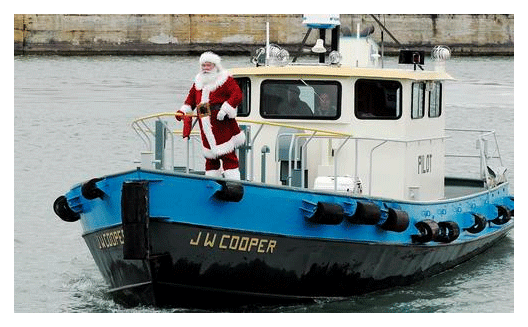Port Colborne - Home Town!
Port Colborne, ON, Canada is located on the north shore of Lake Erie approximately 32 kilometres from the east end of the lake.
The city is home to 18,500 year round residents. With its lakeside location and a number of fine sandy beaches, the summer population soars to over 25,000.
Widely recognized as a small city with an outstanding quality of life, Port Colborne is also a visitors' destination for relaxing times and the famous Canal Days Marine Heritage Festival held annually on the first weekend of August. Started by the Port Colborne Marine Museum in 1977 as a single day event, the Canal Days Marine Heritage Festival now extends over four days and spans the entire city with events and venues.
Christmas in Port Colborne:
Since Port Colborne is a lake port on Lake Erie and at the southern terminus of the Welland Canal portion of the St. Lawrence Seaway System, everything takes on a special maritime flavour.
Each year Santa Claus arrives in Port Colborne on a tug boat on the first Saturday afternoon in December. Later in the evening, Santa is the star of the annual Santa Claus parade which wends its way through the downtown and along historic West Street beside the Welland Canal.

Image courtesy of The Tribune.
In addition to the crowds of children, parents and grand parents who await Santa along the Canal wall on West Street, he is always saluted by the student choir from McKay Elementary School. Following his arrival, hot chocolate is served as Santa holds court in a downtown store.
On Sunday, the Port Colborne Historical and Marine Museum hosts its annual Grand Old Christmas Festival at the museum on King St. from noon until 4 p.m. The first edition of the Museum's Christmas Festival was held in 1976 and it has been a mainstay of Christmas festivities ever since.
The festival features the museum's heritage village, where visitors can see a blacksmith, visit with Santa beside a fire, try log sawing and candle dipping, print a souvenir card and have a horse-drawn carriage ride.
Celebrations with a family flavour are part of the small town heritage and are at the heart of what makes this a very special place to live.
The History of Port Colborne:
In pre-colonial times, the Neutral Indians lived in the area, due in part to the ready availability of flint and chert from outcroppings on the Onondaga Escarpment. As Europeans moved west from the Atlantic and introduced firearms to the native inhabitants, the flint and chert outcroppings diminished in importance.
The westward push of the Iroquis nation led to a series of conflicts between the Iroquois and the Neutrals around 1650 as part of the Beaver Wars.
Originally called Gravelly Bay, after the shallow, bedrock-floored bay upon which it sits, the modern City of Port Colborne traces its roots back to the United Empire Loyalist settlements that grew up in the area following the American Revolution.
The first European settlers in Gravelly Bay arrived from Pennsylvania in the late 1780s following the American Revolution.
A small mill was built by United Empire Loyalist Christian Zavitz and was operated by his son, Jesse. It was located at the Lake Shore outlet of the Mill Pond (Eagle Marsh Drain at Gravelly Bay in Port Colborne) from 1780-1830. It was a prime location for a mill as it had a small flowing stream into Gravelly Bay which drained a large part of the two marshy townships. During the War of 1812, the mill was likely protected with one or more cannons against possible marine attacks or enemy forces from the United States of America.
As economic growth occurred in the Niagara Region, it became important for ships to find a way to travel from Lake Ontario to Lake Erie and the Upper Lakes of the Great Lakes System. A series of canals was built to join St. Catharines in the north on Lake Ontario to a port on the southern side of the peninsula on Lake Erie.
Growth became focused around the southern terminus of the Welland Canal after it was extended to reach Lake Erie in 1833.The completion of the canal created a bustling community that was surrounded by a strong agricultural area and two towns emerged: Port Colborne, on Lake Erie, and Humberstone, aprroximately one mile north of Gravelly Bay, along an important east-west road from Buffalo, NY in the east to St. Thomas in the west.
As the population rose, Port Colborne was incorporated as a village in 1870 and became a town in 1918. It merged with neighbouring Humberstone in 1952. The enlarged town was then incorporated as a city in 1966.
A concise history of Port Colborne can also be found on the City of Port Colborne's website.
The Port Colborne Historical and Marine Museum on King Street is an important source of information and documentation about the History of Port Colborne. Local historian Don Anger has carefully worked through the archives at the museum and constructed a detailed history of the town, surrounding areas, important citizens and major industries. His work is accurate, authoritative and very readable. Copies of all his books can be obtained at the Museum. It is an interesting and important place to visit for anyone interested in the history of the area and the stories of the people who settled and built this community.
Other sites of note related to Port Colborne:
- Port Colborne Historical & Marine Museum Facebook page
- Port Colborne Wikipedia page
- Port Colborne Public Library




